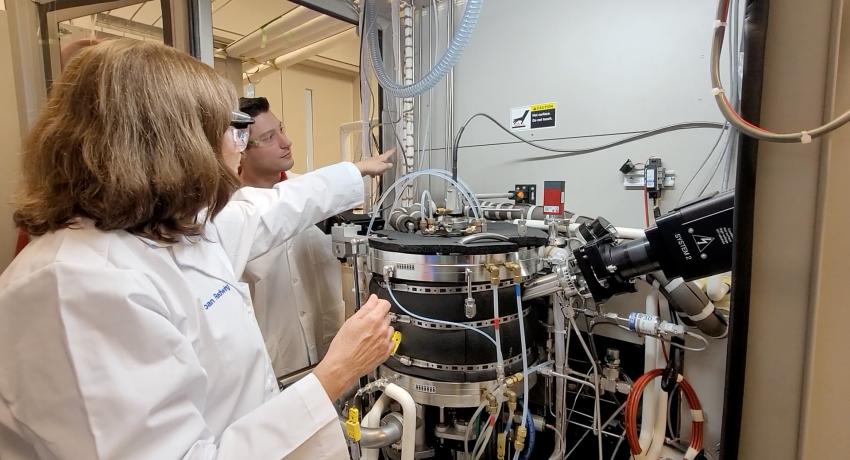Redwing research group in the 2DCC-MIP labs. Credit: Seana Wood/Penn State MRI
By Jamie Oberdick
Two-dimensional materials are vital for the type of semiconductors that will push the future of electronic devices and energy-efficient lighting, but they are a challenge to make. They must have very few defects, difficult given their very small, nano-level size.
Helping Penn State pull off the synthesis of these hard-to-produce materials is Joan Redwing, director of the National Science Foundation-sponsored Two-Dimensional Crystal Consortium (2DCC) – Materials Innovation Platform, and distinguished professor of materials science and engineering and electrical engineering. In these roles, Redwing plays a key part in Penn State’s semiconductor research.
“I work on techniques for making thin films of semiconductors, along with making nano structures like nano wires and two-dimensional films which are also very small in size,” Redwing said. “My research focuses on understanding these processes at an in-depth level so that we can control the properties of the semiconductor material, which is vital because the semiconductor needs to be highly perfect, with no missing atoms or other defects. I study how to control the synthesis of materials at that level so that we can achieve highly perfect films that then are used in electronic and optical devices.”
Redwing and the 2DCC’s work in synthesizing semiconductor materials is a practical benefit for other semiconductor researchers, as they make the difficult-to-create materials that drive semiconductor research forward.
"The materials that my group makes are used by a variety of other researchers at Penn State, who are working on device fabrication, doing characterization of the materials or process development,” Redwing said. "My role is to advance the materials themselves; to develop new materials and structures and to improve the quality of existing materials that we have in support of making better semiconductor devices.”
This is not limited to Penn State. The 2DCC not only provides these materials to Penn State researchers but works with semiconductor experts from industry and higher education institutions beyond Penn State.
"The 2DCC is a national user facility funded by the National Science Foundation,” Redwing said. "That means we have researchers from outside of Penn State who either use the materials that we make, or they come on site to make materials for their own research. So, that is a big way that we collaborate with researchers outside of Penn State.”
Semiconductors are Redwing’s life work. She began her career researching the semiconductor material gallium nitride, playing a part in the development of these materials for use in blue-light emitting diodes which is the basis for all of today’s LED lighting. Currently, one of Redwing’s specialties is the main manufacturing technique for making gallium nitride materials for device application – metalorganic chemical vapor deposition.
The ubiquitous use of LED lights in so many applications makes gallium nitride an important semiconductor material, similar to silicon.
“LEDs have so many uses, more than just lighting your house or as decorative lighting," Redwing said. “For example, they are used in backlighting of displays in cell phones and laptops which has enabled the displays to become much thinner and lighter weight than in the past. These are just a few of the tremendous number of ways in which developing new semiconductor materials like gallium nitride have enabled us to have new devices and new applications that we just would not have otherwise.”
Redwing notes that many of the students who have passed through her research group have moved on to semiconductor-related careers, many of them with Intel. Given that semiconductors are only becoming more important as applications such as the growing use of smart devices, they provide a variety of employment opportunities that will only increase with the CHIPS Act becoming law.
“I am really excited about the CHIPS Act passing because this is going to give my students even more opportunities in the future,” Redwing said. “A lot of the U.S. semiconductor companies were not only doing manufacturing abroad but also a lot of their R&D, so my students were losing job opportunities in the U.S. I am happy that the U.S. is making this investment. The public should understand that semiconductors are as important, if not even more important, for our society’s future as oil and gas are now.”
This article originally appeared in the Fall 2022 issue of Focus on Materials.

